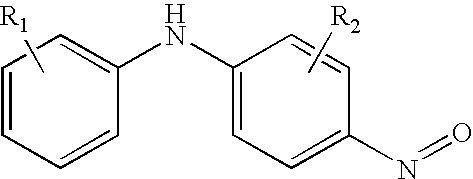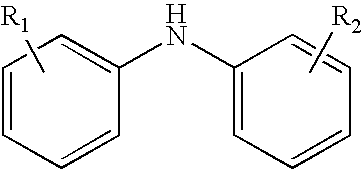C-nitrosoaniline compounds and their blends as polymerization inhibitors
a technology of c-nitrosoaniline compounds and inhibitors, which is applied in chemical inhibitors, hydrocarbon purification/separation, hydrocarbons, etc., can solve the problems of equipment fouling, loss of monomers, undetectable polymerization of ethylenically unsaturated monomers, etc., to enhance the inhibiting activity of said inhibitors, prevent premature polymerization, and effective inhibiting amount
- Summary
- Abstract
- Description
- Claims
- Application Information
AI Technical Summary
Benefits of technology
Problems solved by technology
Method used
Image
Examples
examples
Procedure for Dynamic Reboiler Test with Feed Shut-Off
Preparation of Feed Solution.
[0140]T-Butylcatechol (TBC) is removed from commercially available styrene by distillation under vacuum. Removal of TBC is verified by caustic titration. The desired amount of inhibitor(s) is added to this TBC-free styrene either directly or by first making a concentrated solution of the inhibitor in TBC-free styrene followed by further dilution with TBC-free styrene.
Procedure for Reboiler Test under Ambient Conditions
[0141]A quantity of the Feed Solution containing inhibitor (blend) at the desired charge (stated as a wt / wt total inhibitor to styrene) is added to a round-bottom flask (the “Pot”) and heated to the desired temperature (usually 116° C.) and brought to reflux by adjusting the pressure / vacuum. Once the Pot contents are at temperature, a continuous stream of fresh Feed Solution is begun at a rate that will add the volume of the initial Pot solution to the Pot over a period of time called th...
PUM
| Property | Measurement | Unit |
|---|---|---|
| Time | aaaaa | aaaaa |
| Fraction | aaaaa | aaaaa |
| Fraction | aaaaa | aaaaa |
Abstract
Description
Claims
Application Information
 Login to View More
Login to View More - R&D
- Intellectual Property
- Life Sciences
- Materials
- Tech Scout
- Unparalleled Data Quality
- Higher Quality Content
- 60% Fewer Hallucinations
Browse by: Latest US Patents, China's latest patents, Technical Efficacy Thesaurus, Application Domain, Technology Topic, Popular Technical Reports.
© 2025 PatSnap. All rights reserved.Legal|Privacy policy|Modern Slavery Act Transparency Statement|Sitemap|About US| Contact US: help@patsnap.com



